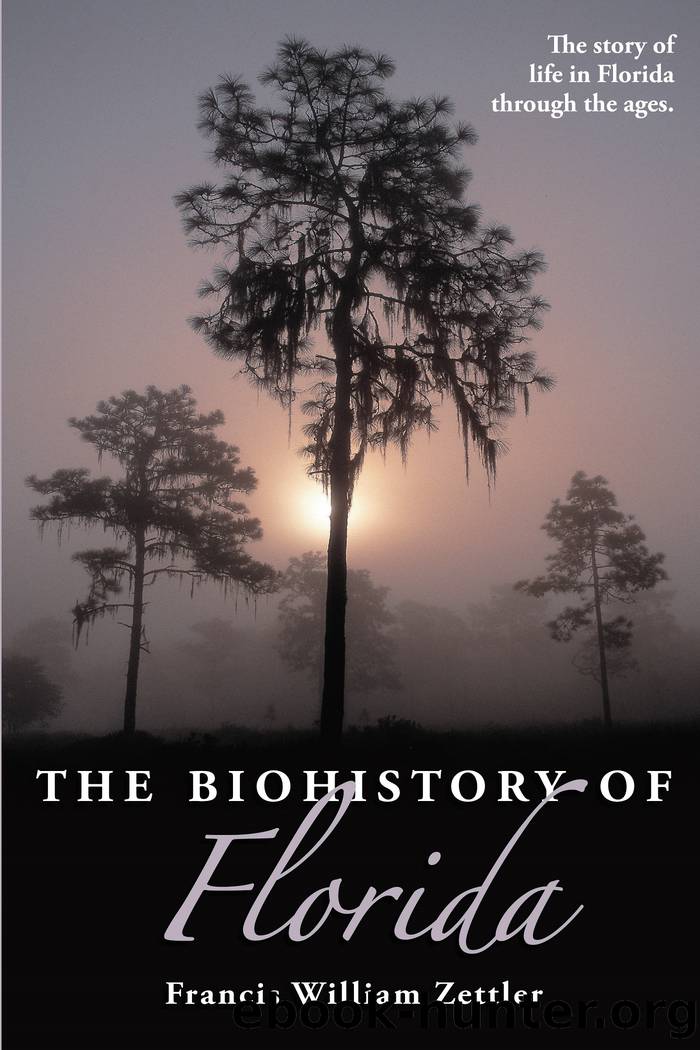The Biohistory of Florida by Zettler Francis William;Zettler Francis William;

Author:Zettler, Francis William;Zettler, Francis William;
Language: eng
Format: epub
Publisher: Pineapple Press
Published: 2016-06-10T17:03:06+00:00
The Anglo-Appalachian Heritage of Floridaâs White Settlers
The overwhelming majority of Floridaâs white settlers (or their immediate ancestors) during the 19th century were originally from Northern Ireland (âUlsterâ), Scotland, Wales, and the borderlands of northern England. Most were dirt poor and compelled to emigrate. Conditions in their former homelands were becoming ever more bleak as overpopulation, famine, disease, and incessant wars took their toll, particularly on the landless peasants.
During the colonial period the population of Britain rose exponentially, greatly exceeding the landâs human carrying capacity at the time, as it did throughout most of Europe. In the British Isles (including Ireland) it rose from a nadir of only 3.5 million in 1400 to 16 million in 1800, a 4.5-fold increase. As noted by the famous contemporaneous English cleric and scholar, Thomas Malthus:
The power of population is so superior to the power of the earth to produce subsistence for man, that premature death must in some shape or other visit the human race. The vices of mankind are active and able ministers of depopulation. They are the precursors in the great army of destruction, and often finish the dreadful work themselves. But should they fail in this war of extermination, sickly seasons, epidemics, pestilence, and plague advance in terrific array, and sweep off their thousands and tens of thousands. Should success be still incomplete, gigantic inevitable famine stalks in the rear, and with one mighty blow levels the population with the food of the world. (1798)
Not every place in Europe suffered equally during this time and some, such as the Netherlands, actually thrived. Others, however, such as Germany, also suffered grievously. One chronicler, Mary Wortley Montagu, traveling through the famous but war-torn German city of Nuremberg in 1716, described the place as having ânarrow nasty streets out of repair, . . . and above half of the common sort asking alms.â Elsewhere, such as in parts of the Scottish Highlands, the situation was even worse.
Most of the year food was scarce, so clansmen supplemented their income by stealing from neighboring clans, with elaborate and daring cattle raids. . . . Some observers estimated that at any given moment the average chief had half his warriors out stealing his neighborâs cattle, and the other half out recovering the cattle his neighbors had stolen from him. In summer, families lived on milk and whey from their cattle, and little else. Bread was available only in the spring, . . . Deprived of other sources of protein, Highlanders often had to bleed their cattle, mixing the blood with oatmeal and frying it in the fire. Sometimes cows were bled so frequently they could barely stand. (Arthur Herman, 2001)
For many people living in such places, emigration was the only recourse. The situation with the deluge of immigrants from northern Britain and Northern Ireland parallels that of the Pennsylvania Dutch in many respects. For example, the Rhine River, which conveniently flows north from Switzerland through Germany and France, the Low Countries (the Netherlands and Belgium), and on
Download
This site does not store any files on its server. We only index and link to content provided by other sites. Please contact the content providers to delete copyright contents if any and email us, we'll remove relevant links or contents immediately.
How to Do Nothing by Jenny Odell(2651)
A Forest Journey by John Perlin(2588)
The Plant Messiah by Carlos Magdalena(2458)
Babylon's Ark by Lawrence Anthony(2073)
Energy Myths and Realities by Vaclav Smil(2066)
The ESV Study Bible by Crossway Bibles(1952)
Abbey in America by Murray John A(1810)
Fatal Storm by Rob Mundle(1792)
Witness Tree by Lynda V. Mapes(1698)
Shadows on the Gulf by Rowan Jacobsen(1520)
Client Earth by James Thornton(1506)
Brokeback Mountain by Annie Proulx(1473)
Coming Back to Life by Joanna Macy(1467)
Water Rights and the Environment in the United States by John Burch(1415)
Cosmos by Carl Sagan(1404)
Ten Billion by Stephen Emmott(1384)
Mycelium Running: How Mushrooms Can Help Save the World by Paul Stamets(1290)
The overachievers by Robbins Alexandra(1287)
The Uninhabitable Earth by David Wallace-Wells;(1196)
